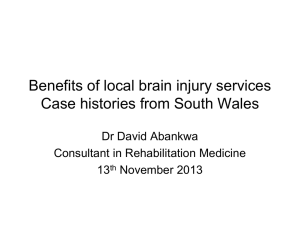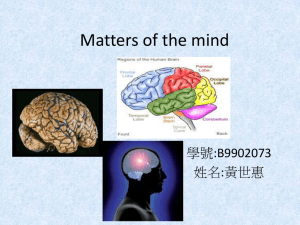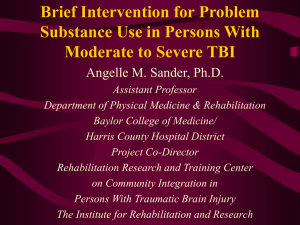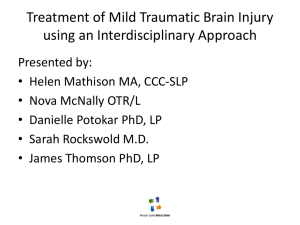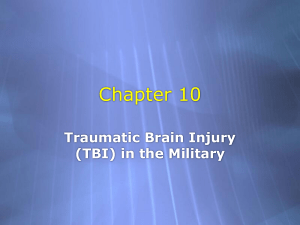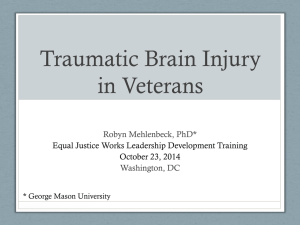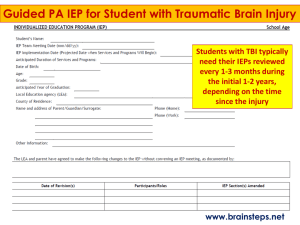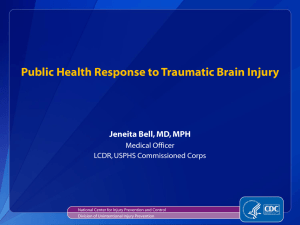n=1 - Washington Traumatic Brain Injury Council
advertisement
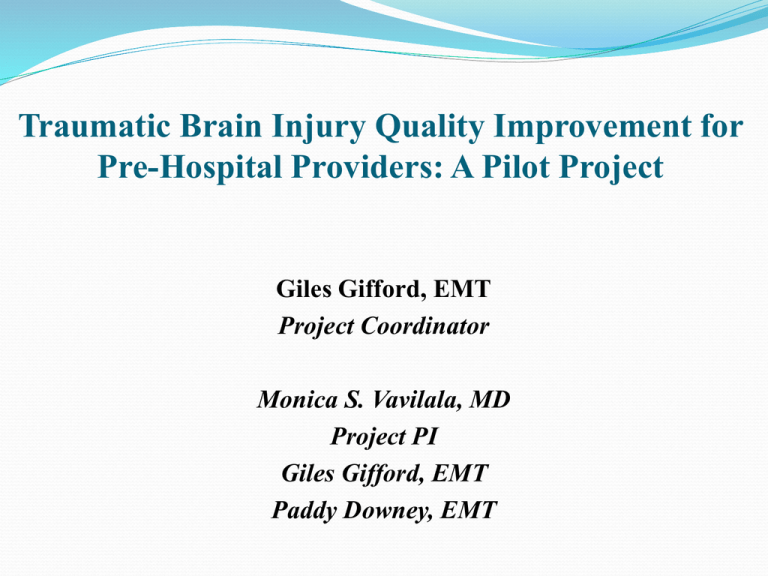
Traumatic Brain Injury Quality Improvement for Pre-Hospital Providers: A Pilot Project Giles Gifford, EMT Project Coordinator Monica S. Vavilala, MD Project PI Giles Gifford, EMT Paddy Downey, EMT Traumatic Brain Injury (TBI) Leading cause of morbidity and mortality Yearly 1.7 million people sustain TBI ~1.36 million are treated in ED and discharged 275,000 hospitalized 80,000 to 90,000 disabled 52,000 die 5.3 million (~ 2%) are living with TBI disability ~1% of severe TBI survive in a persistent vegetative state In 2000, estimated lifetime direct medical costs and indirect costs (e.g., loss of life long productivity) from TBI = 76.5 billion dollars National TBI Guidelines BTF (2007) Evidence based guidelines for severe TBI care Pre-hospital component Pre-hospital care assessment, treatment and transport guidelines separated into 7 areas (ALS and BLS) PHTLS One didactic chapter TBI Care Protocols in WA State No state TBI protocol specific for TBI Two EMT-B (BLS) protocols Adherence required by DOH for all 39 counties General trauma assessment Head and spine injury No standard EMT-P (ALS) County MPD decides protocols for assessment, treatment and transport Current WA State CME State DOH has EMT-B protocols in place County MPD decides how EMTs maintain certification OTEP – Ongoing Training and Evaluation Program Competency based - no set number of hours per year Series of topics (Cardiac, OBGYN etc.) Given by MD or certified trainer in person or video recording Cognitive/written exam Practical portion to demonstrate proficiency EMS online – online educational modules with case studies, written exam and in person practical skills assessment Accreditation EMTs must recertify every 3 years No current TBI module Problems No uniform guidelines Pre-hospital education Lack of benchmarking Adherence to national guidelines unclear HIPRC Aims Examine current TBI Education Present techniques to improve TBI care Project Overview Year 1 (2010-2011): Benchmarking and Education Do we adhere to national guidelines in WA State ? Can we develop a training module for state ? Year 2 (2011-2012): Development and Pilot TBI QI Bundle What TBI QI processes exist nationally ? Develop the QI bundle (module, documentation, cases) Pilot the QI bundle Evaluate QI bundle effectiveness County Adherence: Oxygenation and Blood Pressure BTF Guidelines Yes (n=23) No (n=23) Some (n=23) Monitor for hypoxemia (SpO2 < 90% ) 2 (9%) 9 (39%) 12 (52%) Monitor for hypotension SBP < 90 mmHg for age > 13 yrs 4 (17%) 8 (35%) 11 (48%) Assess oxygenation every 5 min. Continuous monitoring if possible 1 (4%) 14 (61%) 8 (35%) Assess BP every 5 minutes. Continuous monitoring if possible 1 (4%) 12 (52%) 10 (44%) Total counties = 39 7 No ALS providers, 9 No TBI elements Year 1 Summary Benchmarked WA State ground, county ground, and air ambulance protocol language and content 2. Learned pre-hospital providers want more TBI education 3. Delivered 1. 1. 2. 3. 4. ppt module to DSHS for dissemination DOH approved module for CME Module posted on EMS online Module posted on HIPRC website Year 2 Aims (2011-2012) Develop TBI QI bundle 1. 2. 3. Educational module Score PCRs using TBI audit tool In –person case discussions Pilot and Evaluate TBI QI Bundle 1. 2. 2 rural and 2 urban counties Outcomes 1. Change in 2. PCR documentation of TBI indicators pre and post bundle (audit score) Pre and post education test score (knowledge) Pre-hospital provider satisfaction Evaluation of WA State Pre-Hospital QI Process No written template for QI process QI at county level, under MPD direction Board 5-6 members selected by MPDs ER nurses, paramedics and other physicians Confidentiality agreement Meets 1 to 2 times/ year to review EMS patient care reports (PCR's) focusing on area of review Development of Audit Tool Research existing written pre-hospital TBI QI processes Internet search of state, county, municipality protocols US Found 4 with written templates addressing some TBI elements NY (State), CA (County), PA (Pittsburgh), FLA (Miami) Selected “poorly faring or important” WA state indicators for benchmarking 20 Audit Tool Indicators: Mechanism of injury • Antecedent events • Kinematics • Witness accounts C-Spine precautions Hypoxia prevention Intubation indicators TBI signs and symptoms Serial capnography values Loss of consciousness Post intubation RR Serial Vital Signs - Q5 IV fluid initiation Serial GCS scores – Q5 Glucose value Pupillary exam – Q5 Transport decisions ETOH/ drug use 14 Score 1 = complete documentation of indicator Maximum = 20 ALS, 16 BLS, 11 No Transport Recruitment of Counties WEMSIS considered Electronic data capture with pre-collected indicators of “head trauma” System capabilities and state contributions Direct recruitment MPD list of contacts Email invitation Phone project introduction Scheduled in person training QI Bundle Before training, each MPD sent ~20 PCRs to HIPRC Training 1. Audit tool introduction 2. Baseline county results 3. Pre-test 4. Education module 5. Case study 6. Post test 7. Satisfaction survey Second set of PCRs due 6 months after training County Enrollment Email List to 39 County MPDs Response Rate (n=15; 38%) Phone Call (n=11; 28%) Sent PCR’s & Scheduled Training (n=10; 26%) Training Complete (n=10; 26%) 5/20 High Risk Counties 5/19 Low Risk Counties PCR Review Sample 84% electronic 16% paper Electronic PCRs more indicators than paper Paper PCR Too much free text Data fields not prompted PCR Review Associated with pictures May be helpful to understanding mechanisms 198 PCRs From 10 Counties (2008-2011) Total Score Possible 20 Total Score Possible: 20 Average Total Score Possible: 16 15 Total Score Possible: 11 10 5 0 ALS BLS • Room for improvement No Transport Number of 10 Counties with Poor (0-49%) Documentation on PCR (n= 198) 10: GCS reassessed every 5 minutes 10: Pupil reassessment 9: VS reassessment every 5 min 9: Glucose check 9:Capnography used after ETT with serial readings 8: Pupil examination with component parts 5: ETT ventilation rate supported 3: ETOH or drug use 3: Post tracheal intubation RR documented 2: Completed vital signs 1: GCS with component parts Outreach: Module & Case Discussion 12 site visits to 10 counties: 2 counties requested 2 A total of 190 EMS personnel attended: County MPD, all EMT levels, county training coordinators, ER triage nurse, county EMS directors Pre & Post Training Quiz 1. Same 10 question quiz to assess effectiveness 2. Questions based on need Signs & symptoms (3) GCS (3) Ventilation (2) Cerebral herniation (1) Transport decisions (1) 3. Satisfaction survey Overall Pre and Post Test Score Change P < 0.0001 Question 6 - GCS (True/False) “Squeeze my hands” counts as obeying a verbal command 1 0.9 0.8 0.7 Score 0.6 0.5 0.4 0.3 0.2 0.1 0 Total Pre-test ~ 8% Post-test ~ 89% Question 8 - Ventilation Patient presents with extensor posturing, fixed dilated pupils, SpO2 90%, EMT –P should: A) Intubate and hyperventilate B) Intubate and normoventilate C) Administer 25 Liters/min. non-rebreather mask 0.8 0.7 0.6 Score 0.5 0.4 0.3 0.2 0.1 0 Total Pre-test ~ 17% Post-test ~ 73% Documented Improvement Signs and symptoms scores increased for all questions GCS familiarization increased for all questions Cerebral herniation recognition increased by 9% Knowledge of appropriate transport decisions increased 10% Change in Test Scores By County 57%-79% 46%-73% 61%-72% 55%-57% 62%-78% 55%-71% 55%-81% 73%-88% 49%-78% 55%-86% = Counties with greatest improvement Follow up with MPDs Emailed 1. Audit scores a week after site visit 2. Training module 3. Audit tool for use Training Satisfaction (n = 190) = Yes = Neutral = No = No Response Comments from EMS and MPD EMTs Good to stress GCS scores because they don’t get used enough Great review and good reminders of what we need to be looking for Always a good thing to review and keep current on, great job Very informative and provided new thoughts about head trauma QI audit tool is a good tool to add to the patient report chart MPDs Practical aspect to training BLS to ALS Handoff No N/V, dizziness stressed in training Year 2 Lessons Learned 1. Counties want this training (recruited 10, not 4) 2. Pre-hospital setting may benefit from a QI process 3. MPDs are willing to participate Next Steps Obtain follow up PCRs from counties Filter these reports through audit tool Report areas of improvement Especially in areas with low adherence Publish process and findings Dissemination and Implementation study Whatcom County EMS/TC Council’s 31st Annual Conference on Pre-Hospital Medicine October 26-28, 2012, Bellingham WA Friday, October 26, 2012 3:20 – 4:20 Traumatic Brain Injury, Patty Downey 1. TBI is a leading cause of morbidity and mortality in Washington State. 2. EMS of all levels play an important role in the detection and treatment of TBI. 3. Early recognition and timely management of TBI by emergency medical personnel is essential 4. Please join us for a CME training based on the Brain Trauma Foundation’s guidelines for the prehospital TBI management Acknowledgements of Study Partners Agencies DSHS DOH BIAWW EMS On-line State Counties People Mike Lopez Kathy Schmidt Terry Redmon Deborah Crawley Deepak Sharma Charles Mock Eileen Bulger Mickey Eisenberg Acknowledgements of Participating County MPDs & Staff Dr. Sandra Smith-Polling Steve Gordon Palmeroy Colleen Rodriguez Dr. Michael Luce Richard Naumann Dr. Russell Smith Mark Bryan Bob Gwynn Dr. Marvin Wayne Sean Farnand Dr. Terry Murphy Dr. Lance Jobe Rinita Cook Dr. Don Slack Dr. Patrick O’Neill Dr. Michael Sullivan Mik Preysz Patrick Shelper Last slide Results for Oxygenation and Blood Pressure Across all 7 BTF Indicators • State level EMT-B protocol (n=1): • 2 indicators partially matched • 5 did not match • % Counties of n=23 that matched on 7 BTF indicators: • Fully= 0-17% • Partially = 0-48% • None = 35-100% Year 1: Pre-Hospital Focus Group Results Current CME methods well liked Most EMTs they had knowledge of triage/transport criteria 50% felt adequately prepared to treat TBI but were not familiar with their county protocol Wanted more education on Secondary insults GCS Elderly needs Symptom recognition Altered LOC ETOH Concussion Year 1: Module Development ALS http://depts.washington.edu/hiprc/Education%20and%20Tra ining/EMS%20Training%20Module/PART3A.ALS.PPT.pdf BLS http://depts.washington.edu/hiprc/Education%20and%20Tra ining/EMS%20Training%20Module/Part3-B.BLS.PPT.pdf County Risk PCR –No Transport X/11 PCR BLS X/16 PCR –ALS PCR – ALS NO ETT ETT X/17 X/20 Pretest Average Posttest Average Whatcom High 5.8/11 7.6/16 n=7 11.6/17 57% 79% N/A 11.8/17 61% 72% 46% 73% 62% 78% 55% 57% 55% 71% 55% 81% 73% 88% 55% 86% 49% 78% n=6 Skagit High N/A 13.2/20 n=10 n=6 10/20 n=17 San Juan Low 4.4/11 n=9 Jefferson High 5/11 n=1 Chelan Low N/A 10.5/16 n=1 12/17 11.5/16 n=2 11.2/17 N/A 13.1/17 n=3 17/20 n=9 n=1 13/20 n=11 n=7 13.3/20 n=7 Douglas Low N/A N/A 13.1/17 n=5 13.3/20 n=7 Grant Lewis Klickitat Columbia High High Low Low N/A N/A N/A N/A N/A n=5 12.3/17 n=20 15.1/20 4.5/16 n=1 11.1/17 14.7/20 10.7/16 n=3 11.8/17 n=13 14.5/20 10.8/16 n=12 12.1/17 8/20 n=4 n=17 n=6 n=5 n=2 n=1 Year 1 Aims 1. Examine WA state language and content adherence to national guidelines for severe TBI 2. Examine needs and opportunities for pre-hospital TBI education 3. Develop a pre-hospital curriculum for TBI in WA state Year 1 Methods Benchmarking against 7 BTF areas, each with multiple recommended indicators 1. 2. 3. 4. 5. 6. 7. Assessment: Oxygenation and Blood Pressure Assessment: Glasgow Coma Scale Score Assessment: Pupil Examination Treatment: Airway, Ventilation and Oxygenation Treatment: Fluid Resuscitation Treatment: Cerebral Herniation Transport: Transport decisions Focus groups, phone interviews and written surveys EMTs in each county BIAWW EMS conference Educational module Year 1 Benchmarking Results Of 39 counties in WA State 7 (18%) do not have any ALS protocols for anything 9 (23%) have ALS but not specific “head trauma or TBI” protocols 23 (59%) have ALS and addresses “head trauma or TBI” components BTF Assessment Example: Oxygenation and Blood Pressure • Each indicator compared with current WA State EMT-B TBI protocols, WA State county ALS TBI protocols and two private air ambulance companies • Indicator adherence at the state, county and air ambulance company level • Protocols grouped as meeting BTF guideline recommendations: • All = meets all • Some = meets some • None = matches none Part 1-B Literature Review A Pub Med search was conducted with key words TBI and prehospital – 207 results Excluded results prior to March 2007 Excluded editorials Pediatric and Animal studies excluded 7 studies remained relevant 6 had findings concurrent with the BTF guidelines 1 study advocated slightly different acceptable PaCO2 levels PCR Review •Electronically written PCR •Every data field is prompted PCR Review Results Received 201 PCRs from 10 different counties Lewis Co. n=22, range 28%-88%, median 66.5% Skagit Co. n=20, range 30% - 88%, median 65% Grant Co. n=24, range 59%-88%, median 71% Jefferson Co. n=22, range 53%- 88%, median 69% Whatcom Co. n=29, range 36%-81%, median 59% Klickitat Co. n=18, range 56%-88%, median 69% Columbia Co. n=19, range 40%-82%, median 69% Chelan & Douglas Co. n=24, range 48%-91%, median 75% 1 MPD for both counties QI National Review Using established Washington Emergency Services Information System (WEMSIS) data base indicators and the BTF guidelines, a TBI QI Audit Tool was developed to evaluate EMS head trauma responses from participating agencies throughout the state. This was compared nationally to other QI processes that included head trauma at the state, county and city government levels At the State Level - New York has published the only comprehensive quality improvement document complete with sample audit tools. California has QI Audit Tools and guidelines at the County level EMS councils from the cities of Pittsburg and Miami have published QI Audit Tools and Guidelines Question 1 – Signs and Symptoms The following are signs and symptoms of ETOH and not Traumatic Brain Injury A) Slurred speech, vomiting, loss of coordination B) Dilated pupils, convulsions, diminished consciousness D) All of the above E) None of the above Question 2 – Signs & Symptoms (True/False) Hypoxia and hypotension are recognizable and preventable causes of secondary brain injury? Question 3 – Signs & Symptoms (True/False) Tachypnea, tachycardia, change in level of consciousness, and cyanosis are all signs of shock but not hypoxia? Question 4 - GCS (True/False) – The motor component of the GCS focuses only on the upper extremities? Question 5 - GCS What is the GCS score for a patient whose eyes open to pain, withdraws from painful stimuli, and makes inappropriate sounds? A) 3 + 4 + 3 = GCS of 10 (moderate TBI) B) 3 + 3 + 3 = GCS of 9 (moderate TBI) C) 2 + 4 + 2 = GCS of 8 (severe TBI) Question 7 - Ventilation (True/False) Prophylactic hyperventilation - (PaCO2 < 35 mm Hg) should be initiated for every severe TBI patient Question 9 – S&S Cerebral Herniation All of the following are signs/symptoms of cerebral herniation except A) Dilated pupils B) Extensor posturing C) Cyanosis of the fingernails and lips D) Cushings Triad Question 10 – Transport Decisions Patients with severe TBI should be transported to a facility with immediately availiable A) CT scanning B) Prompt neurosurgical care C) The ability to monitor ICP D) Two of the above E) All of the above Training Satisfaction (n = 190) Question 1 = Agree 2 = Neutral 3 = Disagree No Response Did you find the training 115 useful to your knowledge or practice? (60%) 7 9 59 (4%) (5%) (31%) Did you learn how to better 105 assess treat or transport TBI patients? (55%) 14 11 60 (7%) (6%) (32%) Would you recommend this 111 training to your colleagues? (58%) 8 11 60 (4%) (6%) (32%)


